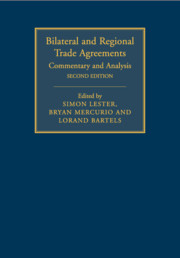Book contents
- Frontmatter
- Contents
- List of contributors
- Foreword
- Table of Cases
- Table of treaties and international agreements
- List of abbreviations
- Part I Introduction
- Part II Economics and politics of PTAs
- Part III Relationship with WTO and international law
- Part IV Legal aspects of PTAs: A comparative analysis
- 8 Agriculture
- 9 Regional trade agreements and trade in services
- 10 Investment
- 11 Government procurement
- 12 Intellectual property
- 13 Social issues: Labour, environment and human rights
- 14 Dispute settlement
- Index
11 - Government procurement
from Part IV - Legal aspects of PTAs: A comparative analysis
Published online by Cambridge University Press: 05 October 2015
- Frontmatter
- Contents
- List of contributors
- Foreword
- Table of Cases
- Table of treaties and international agreements
- List of abbreviations
- Part I Introduction
- Part II Economics and politics of PTAs
- Part III Relationship with WTO and international law
- Part IV Legal aspects of PTAs: A comparative analysis
- 8 Agriculture
- 9 Regional trade agreements and trade in services
- 10 Investment
- 11 Government procurement
- 12 Intellectual property
- 13 Social issues: Labour, environment and human rights
- 14 Dispute settlement
- Index
Summary
I. Introduction
When governments purchase goods or services from private parties for governmental use, it is referred to as “government procurement” or “public procurement”. Examples of government procurement include the awarding of contracts to build roads and buildings, the installation of communications systems and the maintenance of information technology networks. Because governments around the world spend a significant percentage of their budgets on such purchases, government procurement markets are valuable. At the same time, because government officials may use their purchasing behaviour to achieve goals beyond the mere functioning of government, procurement markets can be discriminatory, inefficient, and lack transparency.
As trade in goods and services have become subject to rules on market access and non-discrimination, public procurement practices have likewise come under liberalization pressures. Today, an overwhelming majority of bilateral and regional preferential trade agreements (PTAs) seek to regulate these activities, or at least set out a commitment to do so. While several references to procurement only set forth a goal of procurement market liberalization, many refer to the fuller obligations of the multilateral rules of the WTO's Agreement on Government Procurement (GPA). A small number of other PTAs set out an autonomous regulatory system for procurement trade that includes market access obligations and detailed rules on how governments should seek offers for contracts and the processes by which the offers should be assessed and awarded. These latter agreements even contain rules providing for challenge procedures that can be invoked by disappointed applicants.
Part II sets out in more detail why procurement is subject to international regulation. At a certain level, the rationale for international regulation can be easily explained and understood. Discrimination against foreign suppliers in procurement markets can amount to a significant barrier to trade. International regulation therefore seeks to address distortions in the conditions of competition between domestic and foreign suppliers which can be caused by “buy national” tendencies and measures. Beyond this explanation however, understanding the rationale for international regulation and its relationship with national regulation throws up some challenging conceptual issues. The principles of non-discrimination contained in PTA procurement provisions serve the same purpose as they do in any other trade context: helping all market participants face the same conditions of competition in order to provide consumers with the broadest choice of goods and services at the lowest prices.
- Type
- Chapter
- Information
- Bilateral and Regional Trade AgreementsCommentary and Analysis, pp. 299 - 323Publisher: Cambridge University PressPrint publication year: 2016



